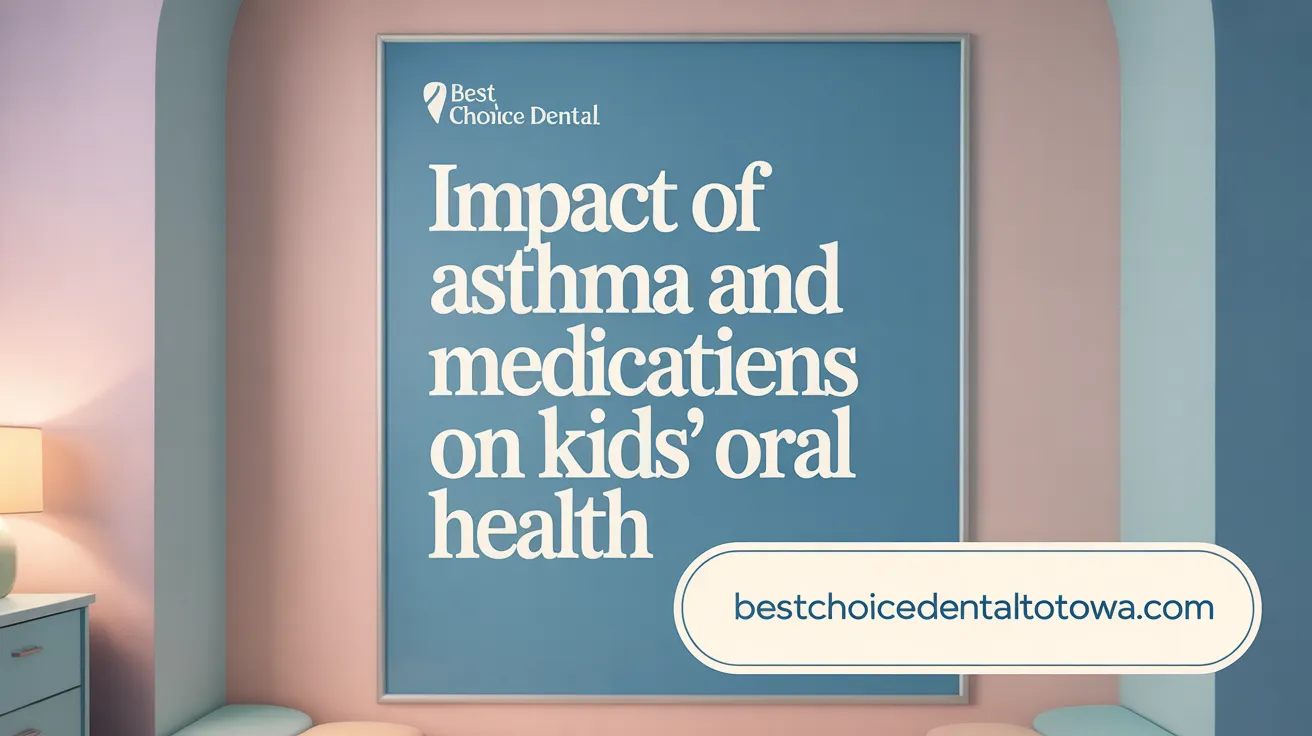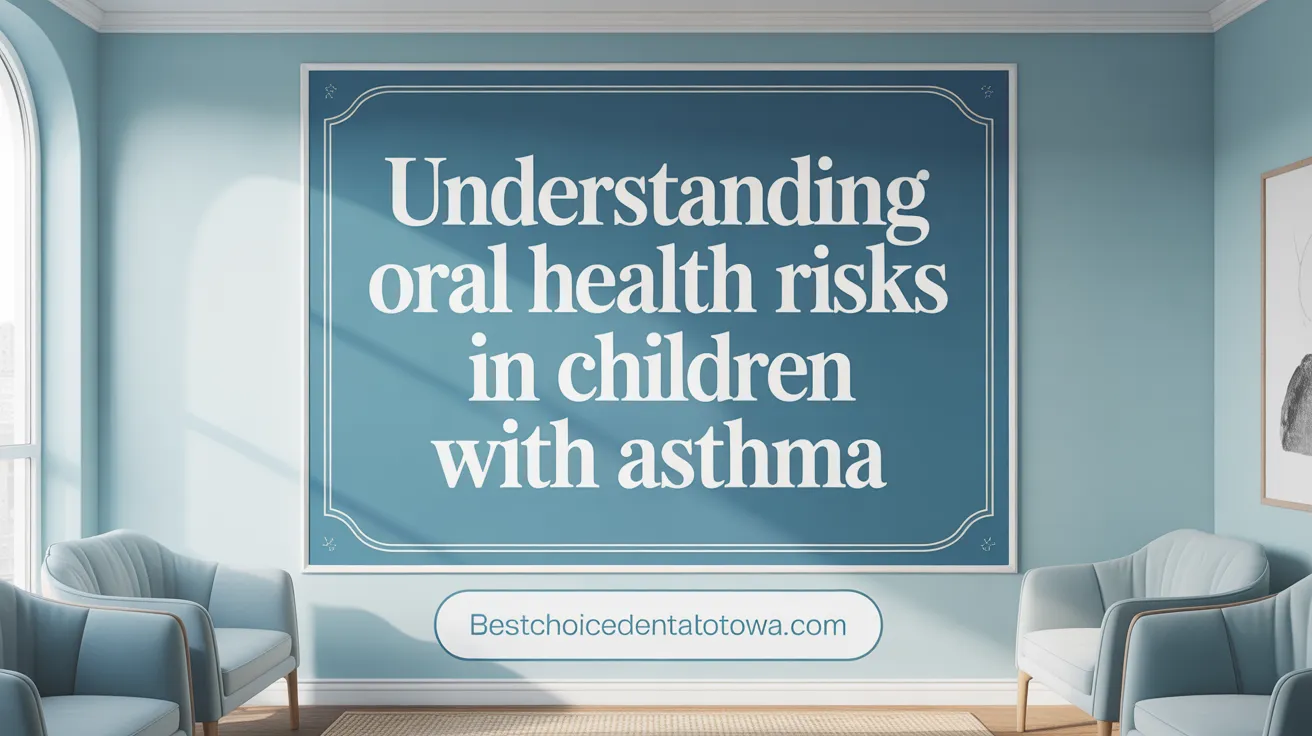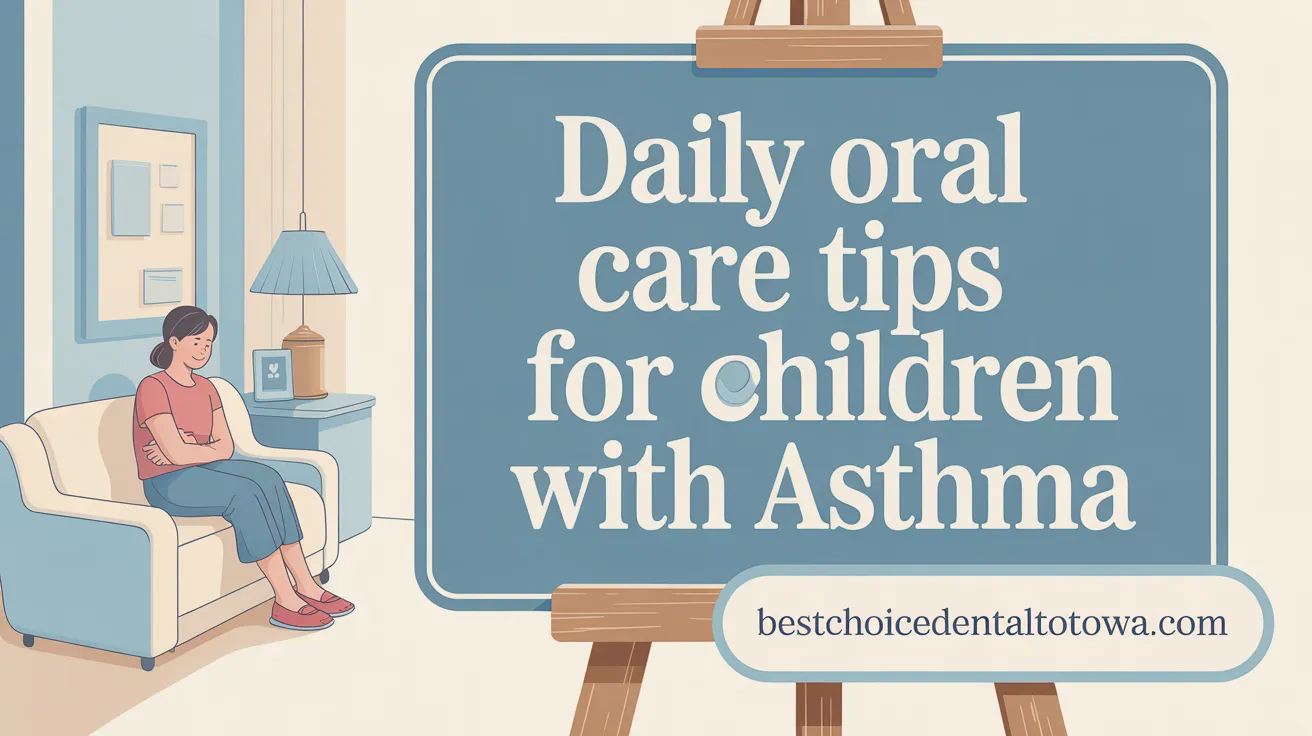Understanding the Hidden Link Between Asthma and Dental Health
Asthma is a common chronic respiratory condition affecting millions of children worldwide. While the respiratory effects are well known, less attention is given to how asthma and its treatment impact oral health. Children with asthma face a higher risk of dental caries, gum disease, and other oral problems partly due to medication side effects and altered oral environments. This article explores the complex relationship between asthma and oral health in children, highlights common challenges, and offers practical guidance for effective dental care to safeguard their smiles.
How Asthma and Its Treatments Affect Children's Oral Health

Effects of asthma medications on saliva and the oral environment
Asthma treatments, particularly inhaled corticosteroids and beta-2 agonists, commonly reduce saliva flow and alter its composition. Saliva acts as a natural defense by neutralizing acids and washing away bacteria. When saliva is diminished, the mouth becomes more prone to bacterial growth and infections.
Increased risk of dental caries and gum disease in asthmatic children
Reduced salivary flow combined with increased plaque buildup raises the risk for dental caries and periodontal diseases in children with asthma. Medications may also encourage growth of cavity-causing bacteria. Mouth breathing, prevalent in asthmatic children, worsens dry mouth, further promoting tooth decay and gum inflammation (oral health in asthmatic patients, oral health risks in asthma management).
Oral candidiasis related to inhaled corticosteroids
Use of inhaled corticosteroids, especially in high doses or prolonged treatment, can suppress local immune defenses like salivary IgA. This immunosuppression facilitates oral candidiasis, a fungal infection presenting as white patches inside the mouth (oral candidiasis and inhaled corticosteroids, Oral thrush caused by corticosteroids).
Impact of mouth breathing and gastroesophageal reflux on oral health
Mouth breathing dries oral tissues, increasing vulnerability to plaque accumulation and gum disease. Gastroesophageal reflux disease (GERD), more common among asthmatic children, exposes teeth to stomach acids, exacerbating enamel erosion and increasing dental sensitivity (gastroesophageal reflux and dental erosion in asthmatics, Mouth breathing effects on oral health.
Dental erosion from acidic inhalers and lifestyle factors
Many inhalers have low pH and acidic components, contributing directly to enamel demineralization. When combined with frequent intake of acidic or sugary beverages and poor oral hygiene, the risk of dental erosion and cavities is heightened (Dental erosion risk from asthma inhalers, Dental erosion caused by powdered asthma medications.
Asthma and its treatments profoundly affect children's oral health by creating conditions conducive to multiple dental problems. Good oral hygiene, use of spacer devices with inhalers, rinsing the mouth after inhaler use, dietary management, and regular dental checkups are essential preventive measures (prevention of oral health issues in asthmatics.
Oral Health Risks Specific to Children with Asthma

What specific oral health risks do children with asthma face?
Children with asthma experience a higher prevalence of dental caries compared to their non-asthmatic peers. This increased risk is largely due to dry mouth caused by asthma medications, especially inhaled corticosteroids and beta-2 agonists, which reduce saliva flow. Saliva is crucial for neutralizing acids and washing away cavity-causing bacteria such as Streptococcus mutans and Lactobacilli.
How do asthma medications affect oral fungal infections?
Prolonged use of inhaled corticosteroids is linked to a higher risk of oral candidiasis, commonly known as thrush. This fungal infection arises from immunosuppressive effects of steroids and a decrease in salivary Immunoglobulin A (IgA), weakening the mouth's defenses. Children using these medications should be monitored closely for signs of thrush.
Why is salivary flow important in preventing cavities?
Reduced salivary flow impairs the mouth's natural cleaning and buffering functions, allowing bacteria to thrive and acid to erode tooth enamel. Asthmatic children with medication-induced dry mouth are therefore more susceptible to cavities and periodontal diseases.
What physical dental manifestations are associated with asthma?
Mouth breathing common in children with asthma can lead to altered facial development, such as increased facial height, a high palatal vault, and a higher prevalence of posterior crossbites. These anatomical changes can impact oral health and require orthodontic attention.
How do diet and oral hygiene habits influence oral health in asthmatic children?
Asthmatic children often consume more sugary and acidic foods and drinks, which combined with poor oral hygiene, escalate the risk for dental caries and erosion. Regular brushing with fluoride toothpaste, flossing, rinsing the mouth after inhaler use, and reducing sugar intake are essential preventive measures to protect their oral health.
Effective Preventive Strategies and Daily Care for Asthmatic Children

Importance of maintaining good oral hygiene
Maintaining proper oral hygiene is essential for children with asthma as they are more susceptible to dental caries and gum disease due to dry mouth and medication effects. Daily brushing twice with fluoride toothpaste and regular flossing help reduce plaque buildup and keep gums healthy (Oral health in asthmatic patients, Oral hygiene for children with asthma, Oral hygiene for children with asthma).
Role of fluoride toothpaste and sealants
Fluoride toothpaste strengthens enamel and helps prevent cavities. Dental sealants serve as protective barriers on molars, reducing sites where bacteria can accumulate. Both are key preventive measures recommended for asthmatic children (Use of fluoride toothpaste and flossing, Dental Sealants for Cavity Prevention, Fluoride varnish to prevent cavities).
Rinsing mouth after inhaler use and using spacer devices
Asthma inhalers can deposit acidic and sugary residues in the mouth, increasing risks for erosion and caries. Rinsing the mouth with water right after using inhalers helps remove harmful substances. Spacer devices attached to inhalers reduce the amount of medication depositing on teeth and oral tissues (Rinsing mouth after inhaler use, Use of spacer devices to reduce oral side effects, Using spacers with inhalers.
Dietary recommendations to reduce cavities
Limiting sugary and acidic foods and drinks reduces the substrate that oral bacteria use to produce acids. Encouraging tooth-friendly foods like vegetables, nuts, seafood and promoting regular water intake supports saliva production and oral health (Diet recommendations to reduce cavities, Dietary advice to reduce tooth decay risk, Diet recommendations for asthma patients.
Parental involvement in children's oral care routine
Parents should supervise and assist children with brushing until around age eight to ensure effectiveness. They should also schedule regular dental visits every six months or more frequently based on risk, discuss medication impacts with dentists, and support healthy dietary habits (Parental assistance with brushing, Dental care advice for parents of children with asthma, Importance of regular dental visits for asthmatic kids).
This comprehensive approach mitigates oral health challenges linked to asthma and its treatment, fostering a healthier smile for children.
Managing Dental Visits Safely for Children with Asthma

Preparing asthmatic children for dental appointments
Ensuring children with asthma take their prescribed medications on time and bring their inhalers to dental visits is essential. Proper rest and reduced anxiety before appointments help prevent asthma exacerbations triggered by stress or fear. Parents should inform the dental team about the child's asthma severity, medication types, allergies, and any recent attacks (Pediatric dentistry for children with asthma, Dental care for children with asthma, Dental management of pediatric asthma patients).
Understanding potential asthma triggers in dental settings
Dental environments can expose children to triggers like inhaled mist, stress, certain dental materials, or latex in gloves. Awareness of these factors enables avoidance or mitigation, reducing the risk of asthma attacks during dental care (Children with respiratory disorders, Dental management of children with asthma).
Communication between dental and medical professionals
Coordinated care involving dentists and pediatricians ensures dental treatments align with asthma control levels. Review of asthma severity, current medication, and any systemic corticosteroid use guides safe planning, including timing of procedures (Dental management of children with asthma, Dental care for children with asthma.
Safe use of sedation and anesthesia
Nitrous oxide sedation is generally safe for children with mild to moderate asthma but should be avoided during active wheezing. Ketamine is considered a safe anesthetic due to bronchodilatory effects and can be used with close monitoring. Avoid aspirin and NSAIDs that could provoke bronchospasm (Dental management of pediatric asthma patients, Children with respiratory disorders).
Emergency management during dental treatment
In the event of an acute asthma attack, dental procedures must stop immediately. Administer inhaled bronchodilators and oxygen promptly. If there is no improvement, epinephrine may be necessary, followed by emergency medical referral. Maintaining ready access to asthma medications and emergency oxygen is critical (Emergency Dental Care for Asthmatic Children, Managing acute asthma attacks during dental treatment.
| Aspect | Key Points | Notes |
|---|---|---|
| Preparation | Medication adherence and inhaler availability | Pre-visit rest and anxiety management |
| Triggers in Dental Settings | Inhaled mists, latex, stress, dental materials | Preventative avoidance |
| Professional Communication | Coordination with pediatrician for asthma status | Adjust treatment timing based on asthma control |
| Sedation and Anesthesia | Nitrous oxide (mild/moderate asthma), ketamine (safe) | Avoid NSAIDs and aspirin |
| Emergency Management | Stop procedure, bronchodilator, oxygen, epinephrine | Have emergency protocols and equipment ready |
The Role of Healthcare Collaboration and Ongoing Monitoring

Why is collaboration between healthcare providers important in caring for children's oral health with asthma?
Asthma and oral health in children are closely linked due to the effects of asthma medications and systemic influences. Coordinated care between dentists and pediatricians is crucial in managing these interconnected health aspects effectively (Dental management of pediatric asthma patients, Dental care for children with asthma.
Importance of coordinated care between dentists and pediatricians
Coordination allows healthcare providers to develop individualized care plans that address both asthma control and oral health. Pediatricians provide insight into asthma severity and medication schedules, helping dentists tailor treatments and timing of dental procedures. Dentists, in turn, monitor oral manifestations like dry mouth, candidiasis, and caries risk resulting from asthma therapy (Oral health in asthmatic patients, Dental management of children with asthma.
Regular monitoring of oral health and asthma control
Ongoing assessments enable timely identification of oral side effects from medications such as inhaled corticosteroids or beta-2 agonists. Monitoring also helps track asthma symptom control, ensuring dental treatments are safe and appropriately planned (Asthma medications and oral health, Managing children with asthma in dental care).
Advising families on medication side effects and oral health
Collaborative education empowers families by highlighting the importance of mouth rinsing after inhaler use, using spacer devices, and maintaining oral hygiene. Discussing potential side effects prepares parents to recognize early signs of oral complications and reinforces adherence to both asthma and dental care routines (Asthma and oral health risks, Oral health for asthmatics, Using a spacer to protect teeth.
Tailoring oral health interventions to individual asthma severity
Dental interventions should be customized based on the child's asthma severity and control. For example, children with severe asthma might require cautious scheduling of dental visits, stress management strategies, and preventive therapies like fluoride applications (Impact of asthma severity on oral health, Asthma severity and oral health correlation).
Supporting child and parent education for long-term oral wellness
Joint guidance from dentists and pediatricians encourages healthy habits that persist beyond clinical settings, promoting sustained oral health despite asthma-related challenges (Dental health in children with asthma, Asthma and children's oral health).
By embracing interdisciplinary communication and consistent monitoring, healthcare teams can effectively safeguard the oral health and overall well-being of children living with asthma.
Protecting Smiles: A Holistic Approach to Oral Health in Children with Asthma
Children with asthma face unique challenges that make maintaining good oral health essential but more complex. The interplay between asthma itself, its therapies, and behavioral factors like mouth breathing create conditions favoring dental caries, gum disease, dental erosion, and infections. However, with awareness, effective preventive care, and collaboration among caregivers, dental professionals, and pediatricians, these risks can be significantly reduced. Regular dental visits, proper hygiene practices, dietary control, and open communication about asthma status empower families to protect their children's smiles. Ultimately, integrating asthma management with oral health care ensures a better quality of life and well-being for children living with this chronic condition.
